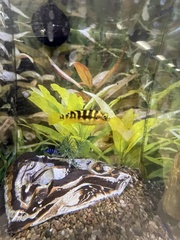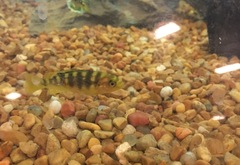Pseudotropheus crabro: taxon details and analytics
- Domain
- Kingdom
- Animalia
- Phylum
- Chordata
- Class
- Actinopterygii
- Order
- Cichliformes
- Family
- Cichlidae
- Genus
- Pseudotropheus
- Species
- Pseudotropheus crabro
- Scientific Name
- Pseudotropheus crabro
Summary description from Wikipedia:
Pseudotropheus crabro
Pseudotropheus crabro, also known as the bumblebee cichlid or hornet cichlid, is a species of cichlid endemic to Lake Malawi where it is found in different habitats but most frequently in large caves or in the vicinity of large boulders. This species can reach a length of 16 centimetres (6.3 in) SL.
The bumblebee cichlid has an elongate body with vertical yellow-and-black "bumblebee" bars. Juveniles are brightly colored but become darker when mature, especially for males. This fish is known for its ability to rapidly change its colors. They are mouthbrooders like many other cichlids from Lake Malawi.
In their natural habitats, the bumblebee cichlid is a cleaner specialized in feeding on parasites from larger fish particularly the catfish Bagrus meridionalis, which apparently recognises the species as a cleaner. Notable is that P. crabro has also been found preying upon the eggs of the Bagrus meridionalis, but will change colour to a dark brown while doing so.
...Pseudotropheus crabro in languages:
- Czech
- tlamovec černožlutý
- English
- Bumblebee Cichlid
- English
- Hornet Cichlid
- English
- Bumblebee Mouthbrooder
- Finnish
- Ampiaismalawinahven
- Russian
- Цихлида-хамелеон
Images from inaturalist.org observations:
We recommend you sign up for this excellent, free service.
Parent Taxon
Sibling Taxa
- Pseudotropheus benetos
- Pseudotropheus brevis
- Pseudotropheus crabro
- Pseudotropheus cyaneorhabdos
- Pseudotropheus elegans
- Pseudotropheus fuscus
- Pseudotropheus galanos
- Pseudotropheus interruptus
- Pseudotropheus johannii
- Pseudotropheus livingstonii
- Pseudotropheus lucerna
- Pseudotropheus perileucos
- Pseudotropheus perspicax
- Pseudotropheus purpuratus
- Pseudotropheus tursiops
- Pseudotropheus williamsi




